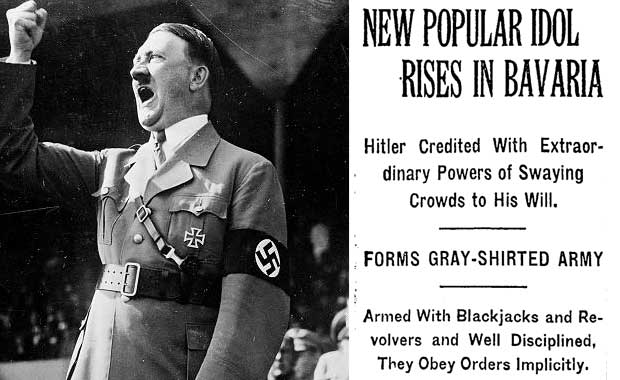Advertisement
Entertainment
First New York Times Hitler Article in 1922 Bears Terrifying Similarities to Today
By
Jason Owen
5 min read
- # 2016 Election
- # Adolf Hitler
- # Bernie Sanders
Advertisement - Continue reading below

“This reactionary Nationalistic anti-semitic movement has now reached a point where it is considered potentially dangerous, though not for the immediate future.”
These words were written on Nov. 20, 1922, in the pages of the New York Times as the publication wrote, for the first time, about Adolf Hitler and his sweeping popularity throughout Germany, bolstered largely by a platform of anti-Semitism that many in the early years of the rise of the Nazi party deemed harmless.
The Times story is striking to some contemporary readers in its parallels to our current politic and economic state, but also may be more pertinent when comparing the widespread appeal of current anti-Muslim rhetoric in America with the anti-Semitic hysteria that gripped Germany throughout the 1920s and 30s.
“Another condition favorable to the outburst of the [National Socialist] movement is the widespread discontent with the existing state of affairs among all classes in the towns and cities under the increasing economic pressure,” wrote Cyril Brown in the 1922 article.
Sound familiar?
Today, numerous polls show Americans of all affiliations are concerned with the direction the country is going, both economically and politically. Economists have warned policy makers for some time that the gap in wealth distribution is dangerously high. Meanwhile, the top one percent of earners continue to take the vast majority of new wealth, while the bottom 99 percent receive little to none of that growth. Voters on both sides of the aisle have become frustrated with this trend.
Noting the political and economic climate of 1920’s Germany is key to understanding the meteoric rise of Hitler, as the Times piece notes. That economic climate is mirrored today, where, as Hitler blamed Jews, many find scapegoats for the problems facing America in the immigrant population and those of the Muslim faith.

As some have watched Donald Trump’s rise to the top of Republican polls, he has not escaped his share of criticism, especially following his public call to build a wall along our Southern border and a proposal to ban all Muslims from entering the United States. That proposal – among others – has drawn endless comparisons between Trump and Hitler.
While it might be quick to think the comparisons hyperbolic, the Times article contains several passages that now seem remarkably prescient.
“Hitler’s program is of less interest than his movement and person. His program consists chiefly of half a dozen negative ideas clothed in generalities. He is against ‘the Jews, Communists, Bolshevism, Marxian socialism, Separatists, the high cost of living, existing conditions, the weak Berlin Government and the Versailles Treaty.’ Positively he stands only for ‘a strong united Germany under a strong Government.'”
For those who have been following Trump’s campaign, the phrase “negative ideas clothed in generalities” may certainly strike a tune.
On illegal immigration, Trump has said he will keep out “criminals” and “rapists” by building a big wall along the Southern U.S. that “Mexico will pay for.” No further details have been provided.
Hitler’s opposition to the Jews could easily be swapped with immigrants, or the anti-Muslim backlash that has swept through a vast majority of the country.
Numerous political leaders have called for banning all Muslims from entering the U.S., or turning away refugees from war-torn Syria, or to a lesser extent, increasing the already lengthy screening process for immigrants to enter the country. The rhetoric has caused a violent backlash against Muslim-Americans living peacefully in the country. Violent campaign rallies became the norm in Hitler’s early rise.
The Times article points to Hitler’s “Hakenkreuz” following, which consisted of fervent followers armed with “blackjacks” who used violence at rallies to silence protesters who opposed Hitler.
“A different exhibition of Hitler power,” says the Times. “During a mass meeting in Nuremberg, a stronghold of Bavarian socialism, the radical elements undertook a counter demonstration, massed outside the meeting hall and sang the ‘Internationale.’ The strains of the hated tune heard in the hall enraged Hitler’s followers. At his word of command shock troops of gray shirts with fine discipline marched from the hall, pulled their blackjacks, charged and dispersed the crowd with many a broken head.”
Trump has seemed to amass an equally agitated coalition behind him – white supremacists included – complete with calls for violence issued from his own mouth.

“If you see somebody getting ready to throw a tomato, knock the crap out of them,” Trump told a crowd after narrowly being hit by a tomato at a rally event in February.
No other candidate – either Republican or Democrat – seems to spur the kind of hatred and vitriol that Trump does. Is it fair to judge him based on his followers? Maybe not. But Trump certainly does little to denounce the violence, and even said, “maybe he should have been roughed up,” after a protester at a Trump rally was punched, kicked, and choked in Alabama.
Many have disavowed Trump – even from his own party – but others simply downplay his remarks as nothing more than a tool to feed on the prejudices of a frustrated people to garner votes.
But to allow the casual acceptance of violence toward those of a differing opinion at this stage in Trump’s candidacy is a warning issued 94 years ago:
“But several reliable, well-informed sources confirmed the idea that Hitler’s anti-semitism was not so genuine or violent as it sounded, and that he was merely using anti-semitic propaganda as a bait to catch masses of followers and keep them aroused, enthusiastic and in line for the time when his organization is perfected and sufficiently powerful to be employed effectively for political purposes.
…
“According to a reliable specialist informant [of the Times author], there are probably 400,000 military rifles and 150 cannon still concealed in Bavaria. So that some fine day Hitler’s legionaires might well make their debut with rifles.”
It is said that history has a way of repeating itself.
Advertisement - Continue reading below












